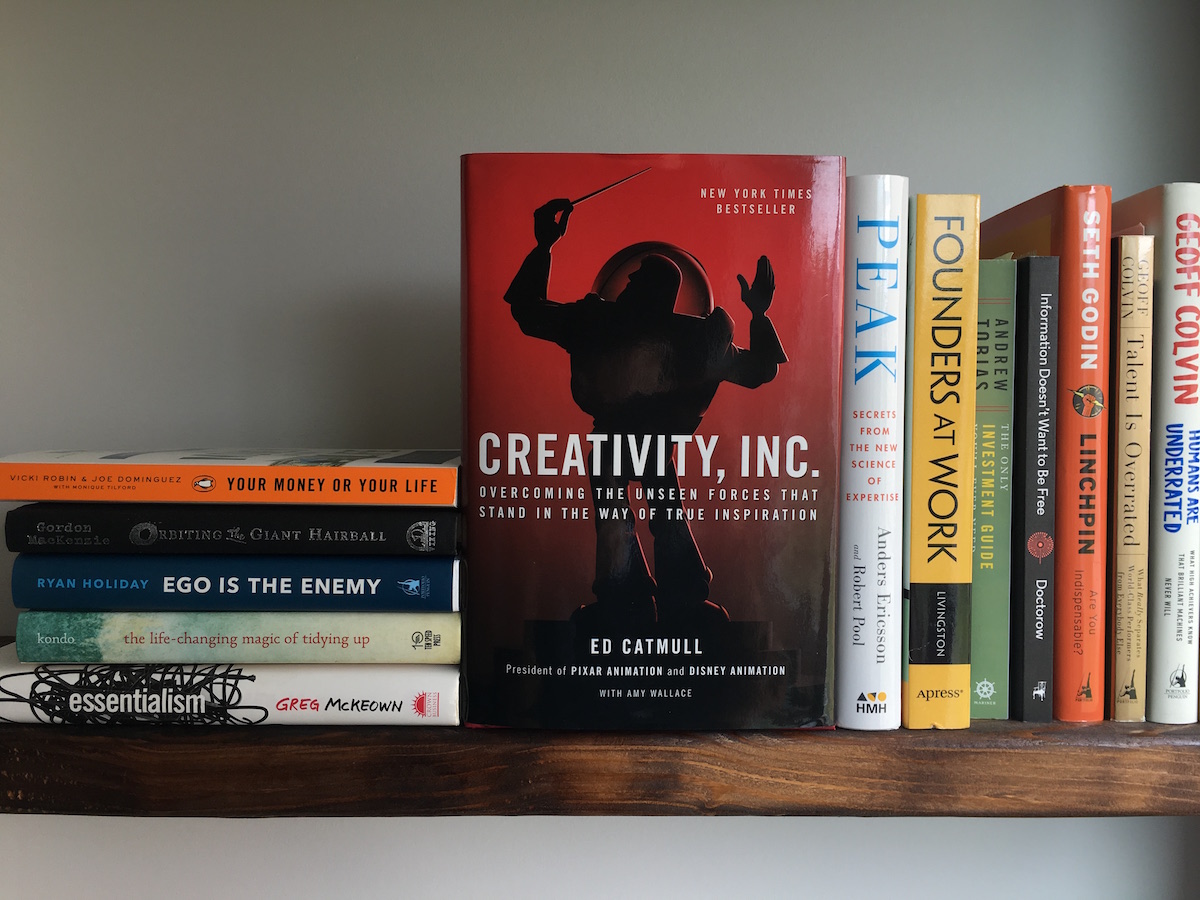Creativity, Inc.
Focus Club: Book Review
by Ed Catmull
Creativity Inc. has quickly become one of our favorite books at Blanc Media. The founder of Pixar Animation offers his lifetime experience of cultivating a creative culture within an ever evolving environment. His pursuit of maintaining candor and honesty from the top down and bottom up is only the beginning of what led to being one of the most celebrated animation companies of all time. Here are some of our favorite quotes from the book.
Buy Creativity, Inc.
-
When it comes to creative inspiration, job titles and hierarchy are meaningless. (pg. 4)
-
You don’t have to ask permission to take responsibility. (pg. 51)
-
If you give a good idea to a mediocre team, they will screw it up. If you give a mediocre idea to a brilliant team, they will either fix it or throw it away and come up with something better. The takeaway here is worth repeating: Getting the team right is the necessary precursor to getting the ideas right. (pg. 74)
-
Without trust, creative collaboration is not possible. (pg. 87)
-
Creativity has to start somewhere, and we are true believers in the power of bracing, candid feedback and the iterative process—reworking, reworking, and reworking again, until a flawed story finds its throughline or a hollow character finds its soul. (pg. 90)
-
People who take on complicated creative projects become lost at some point in the process. It is the nature of things—in order to create, you must internalize and almost become the project for a while, and that near-fusing with the project is an essential part of its emergence. But it is also confusing. (pg. 91)
-
No matter what, the process of coming to clarity takes patience and candor. (pg. 91)
-
We believe that ideas—and thus, films—only become great when they are challenged and tested. (pg. 93)
-
You are not your idea, and if you identify too closely with your ideas, you will take offense when they are challenged. (pg. 94)
-
Candor is only valuable if th eperson on the receiving end is open to it and willing, if necessary, to let go of things that don’t work. (pg. 99)
-
Candor isn’t cruel. It does not destroy. On the contrary, any successful feedback system is built on empathy, on the idea that we are all in this together, that we understand your pain because we’ve experienced it ourselves. The need to stroke one’s own ego, to get the credit we feel we deserve—we strive to check those impulses at the door. The Braintrust is fueled by the edea that every note we give is in the service of a common goal: supporting and helping each other as we try to make better movies. (pg. 104)
-
Seek out people who are willing to level with you, and when you find them, hold them close. (pg. 105)
-
If you aren’t experiencing failure, then you are making a far worse mistake: You are being driven by the desire to avoid it. (pg. 109)
-
In a fear-based, failure-averse culture, people will consciously or unconsciously avoid risk. They will seek instead to repeat something safe that’s been good enough in the past. Their work will be derivative, not innovative. (pg. 111)
-
When experimentation is seen as necessary and productive, not as a frustrating waste of time, people will enjoy their work—even when it is confounding them. (pg. 113)
-
When it comes to creative endeavors, the concept of zero failures is worse than useless. It is counterproductive. (pg. 115)
-
Being too risk-averse causes many companies to stop innovating and to reject new ideas, which is the first step on the path to irrelevance. (pg. 118)
-
To be a truly creative company, you must start things that might fail. (pg. 118)
-
The key is to view conflict as essential, because that’s how we know the best ideas will be tested and survive. (pg. 139)
-
Hold lightly to goals and firmly to intentions. What does that mean? It means that we must be open to having our goals change as we learn new information or are surprised by things we thought we knew but didn’t. As long as our intentions—our values—remain constant, our goals can shift as needed. (pg. 140)
-
We must meet unexpected proglems with unexpected responses. (pg. 163)
-
If we can agree that it’s hard, if not impossible, to get a complete picture of what is going on at any given time in any given company, it becomes even harder when you are successful. That’s because success convinces us that we are doing things the right way. (pg. 173)
-
You’ll never stumble upon the unexpected if you stick only to the familiar. (pg. 197)
-
“Better to have train wrecks with miniature trains than with real ones.” —Joe Ranft (pg. 210)
-
Companies, like individuals, do not become exceptional by believing they are exceptional but by understanding the ways in which they aren’t exceptional. (pg. 215)
-
The attempt to avoid failure, in other words, makes failure more likely. (pg. 222)
-
Andrew likens the director’s job to that of a ship captain, out in the middle of the ocean, with a crew that’s depending on him to make land. The director’s job is to say, “Land is that way.” Maybe land actually is that way and maybe it isn’t, but Andrew says that if you don’t have somebody choosing a course—pointing their finger toward that spot there, on the horizon—then the ship goes nowhere. It’s not a tragedy if the leader changes her mind later and says, “Okay, it’s actually not that way, it’s this way. I was wrong.” As long as you commit to a destination and drive toward it with all your might, people will accept when you correct course. “People want decisiveness, but they also want honesty about when you’ve effed up,” as Andrew says. “It’s a huge lesson: Include people in your problems, not just your solutions.”…”If you’re sailing across the ocean and your goal is to avoid weather and waves, then why the hell are you sailing?” he says. “You have to embrace that sailing means that you can’t control the elements and that there will be good days and bad days and that, whatever comes, you will deal with it because your goal is to eventually get to the other side. You will not be able to control exactly how you get across. That’s the game you’ve decided to be in. If your goal is to make it easier and simpler, then don’t get in the boat.” — Andrew Stanton (pg. 227-228)
-
When looking to hire people, give their potential to grow more weight than their current skill level. What they will be capable of tomorrow is more important than what they can do today. (pg. 316)
-
Always try to hire people who are smarter than you. Always take a chance on better, even if it seems like a potential threat. (pg. 316)
-
If there are people in your organization who feel they are not free to suggest ideas, you lose. Do not discount ideas from unexpected sources. Inspiration can, and does, come from anywhere. (pg. 316)
-
There are many valid reasons why people aren’t candid with one another in a work environment. Your job is to search for those reasons and then address them. (pg. 316)
-
Likewise, if someone disagrees with you, there is a reason. Our first job is to understand the reasoning behind their conclusion. (pg. 316)
-
Further, if there is fear in an organization, there is a reason for it—our job is (a) to find what’s causing it, (b) to understand it, and (c) to try to root it out. (pg. 316)
-
There is nothing quite as effective, when it comes to shutting down alternative viewpoints, as being convinced you are right. (pg. 316)
-
If there is more truth in the hallways than in meetings, you have a problem. (pg. 317)
-
Many managers feel that if they are not notified about problems before others are or if they are surprised in a meeting, then that is a sign of disrespect. Get over it. (pg. 317)
-
The first conclusions we draw from our successes and failures are typically wrong. Measuring the outcome without evaluating the process is deceiving. (pg. 317)
-
Do not fall for the illusion that by preventing errors, you won’t have errors to fix. The truth is, the cost of preventing errors is often far greater than the cost of fixing them. (pg. 317)
-
Failure isn’t a necessary evil. In fact, it isn’t evil at all. It is a necessary consequence of doing something new. (pg. 317)
-
Trust doesn’t mean that you trust that someone won’t screw up—it means you trust them even when they do screw up. (pg. 318)
-
The desire for everything to run smoothly is a false goal—it leads to measuring people by the mistakes they make rather than by their ability to solve problems. (pg. 318)
-
Don’t wait for things to be perfect before you share them with others. Show early and show often. It’ll be pretty when we get there, but it won’t be pretty along the way. And that’s as it should be. (pg. 318)
-
A company’s communication structure should not mirror its organizational structure. Everybody should be able to talk to anybody. (pg. 318)
-
Engaging with exceptionally hard problems forces us to think differently. (pg. 318)
-
An organization, as a whole, is more conservative and resistant to change than the individuals who comprise it. Do not assume that general agreement will lead to change—it takes substantial energy to move a group, even when all are on board. (pg. 319)
-
The healthiest organizations are made up of departments whose agendas differ but whose goals are interdependent. If one agenda wins, we all lose. (pg. 319)
-
Our job as managers in creative environments is to protect new ideas from those who don’t understand that in order for greatness to emerge, there must be phases of not-so-greatness. Protect the future, not the past. (pg. 319)
-
Excellence, quallity, and good should be earned words, attributed by others to us, not proclaimed by us about ourselves. (pg. 319)
-
Do not accidentally make stability a goal. Balance is more important than stability. (pg. 319)
-
Don’t confuse the process with the goal. Working on our processes to make them better, easier, and more efficient is an indispensable activity and something we should continually work on—but it is not the goal. Making the product great is the goal. (pg. 319)
Nice work, !
Congrats on doing today’s assignment.
